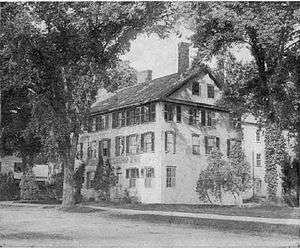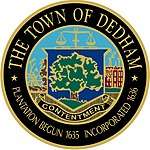Norfolk House (Dedham, Massachusetts)
The Norfolk House is a building in Dedham, Massachusetts that was originally built in 1801 as a two-story, Federal-style single-family home.[1] It was soon thereafter converted into a tavern, and hosted John Quincy Adams, Andrew Jackson, Abraham Lincoln, and the Marquis de Lafayette.[1][2] In the 2010s it was converted into apartments.[3] It has more than 15,000 square feet of living space.[3]
| Norfolk House | |
|---|---|
 Norfolk House at the turn of the 20th Century | |
%26groups%3D_4b922f8cfc73b046283f797844bdca9d0820bc83.svg)
| |
| General information | |
| Architectural style | Federal |
| Location | 19 Court Street, Dedham, Massachusetts |
| Coordinates | 42.248474°N 71.177196°W |
| Construction started | 1802 |
| Completed | 2017 |
| Part of a series on |
| Dedham, Massachusetts |
|---|
 |
| History |
| People |
|
| Places |
| Organizations |
| Businesses |
| Education |
Martin Marsh
During the first few years of the 19th century, several turnpikes, including those linking Boston and Providence and Dedham and Hartford, were laid through Dedham. Inns and taverns sprung up along the new roads as more than 600 coaches would pass through Dedham each day on their way to Boston or Providence.[4] As many as 40 coaches passed through town every day,[3] and Dedham was the first stop on the way to Providence, or the last stop on the way to Boston.[5]
In 1802, a local mason named Martin Marsh built his brick home at what is today 19 Court Street and was then right on one of the new turnpikes.[5] He saw the traffic flowing daily past his house and quickly turned his home into a tavern.[5] His establishment, the Norfolk House, like the other inns and taverns in Dedham at that time, were bustling with the arrival of both the turnpikes and the courts.[5][1] The tavern was affiliated with the Tremont Stagecoach Line.[5] It had a fierce competition with the Gay Tavern's[nb 1] Citizen Stagecoach Line.[nb 2]
Behind the Gay Tavern, which by 1832 had come to be known as Bride's Tavern after its new owner, there was a stable that housed over 100 horses at any given time.[5] Teams of eight horses could be swapped out in two minutes.[5] In 1832, Bride's Tavern burned to the ground after a fire broke out in the stable and killed 67 horses.[5] This fire was originally considered to be an accident, until several years later in 1836 when the rebuilt stable caught on fire again, killing roughly 70 horses.[5] After getting drunk at the Norfolk House, John Wade mentioned that he knew about the fire and was promptly arrested.[5] He eventually confessed to lighting the first, but not the second, fire at the behest of a director of the competing stagecoach line at the Norfolk House.[5]
The original portico of the house was the site of the first recorded traffic accident in Dedham.[5] A runaway carriage crashed into the corner post and broke it.[5] The Norfolk House was also the site where "on June 4, 1810, in an expression of public outrage, a number of Dedham citizens assembled" and founded the Society in Dedham for Apprehending Horse Thieves. Today the "Society is the oldest continually existing horse thief apprehending organization in the United States, and one of Dedham's most venerable social organizations."[6]
Gray and Alden
Marsh maintained the tavern until 1818, and then sold it to Moses Gray and Francis Alden.[5] It was this partnership that hosted President Andrew Jackson for lunch as he and his entourage passed through town in 1832.[5] The Norfolk House was also a hotbed for Republican politics in its day. It competed with the Democratic Phoenix House. The proprietors of the two establishments generally stayed away from each other but "every once in a while they slipped and then there would be a short burst of newspaper venom."[5]
A young Congressman named Abraham Lincoln gave a speech at the Norfolk House on September 20, 1848 while in Massachusetts to campaign for Zachary Taylor.[7][4] He appeared uncomfortable as he arrived but
His indifferent manner vanished as soon as he opened his mouth. He went right to work. He turned up the cuffs of his shirt. Next, he loosened his necktie, and soon after it he took it off altogether. All the time, he was gaining upon his audience. He soon had it as by a spell. I never saw men more delighted. He began to bubble out with humor. For plain pungency of humor, it would have been difficult to surpass his speech. The speech ended in a half-hour. The bell that called to the steam cars sounded. Mr. Lincoln instantly stopped. 'I am engaged to speak at Cambridge tonight, and I must leave.' The whole audience seemed to rise in protest. 'Go on! Finish it!' was heard on every hand. One gentleman arose and pledged to take his horse and carry him across country. But Mr. Lincoln was inexorable.[8]
In 1820, three bays were added to the north of the building.[1] In addition, another bay and a large ell were added to the rear, and the building gained a third story.[1]
Martin Bates
In 1840, Martin Bates purchased the property.[5] He sometimes kept a moose behind the property, and charged admission to see it.[5]
The railroad came to Dedham in 1836, and stagecoach traffic dwindled until it stopped all together in 1842.[5] The temperance movement also put pressure on taverns, and the house ceased to be a tavern in 1866.[1][5] By this time, and especially after an incident in which a group of Irish immigrants from Dedham and Roxbury got drunk and four people were stabbed, Bates was ready to sell the property.[5] Bates tried to sell it to the Town of Dedham, but the Town was not interested.[5] In a fit of spite, Bates then sold it to the Sisters of St. Paul to open an orphanage and school for girls.[5] The school closed in the late 1870s, and then became a flop house, warehouse, and "third rate office building" which, at one point, housed the offices of an "independent clairvoyant and medical reformer."[5][1] During this time the building fell into disrepair.[1]
Recent history
In 1902, Walter Austin, a wealthy pineapple merchant, purchased the home and restored it as a private residence[5] with Frank Chouteau Brown as his architect.[1] It was he who tore down the low portico with a dozen columns under the second story windows and added the larger one in the southern style.[5] Austin also added an additional bay to the house with a covered porch, and an arcade was added to the ell in the rear of the house.[1] Austin would go on to write a book about the history of the house.[9]
It remained a single family home until early the 21st century, but it was only sporadically occupied.[1] From 2000 on, the house sat vacant, for sale but in need of significant repairs.[3] Town Meeting created a new class of zoning, and voted to place the Norfolk House into that zone, allowing for the property to be redeveloped with six apartments that will eventually be sold as condominiums.[3][10]
In 2017, the Massachusetts Historical Commission awarded the house Historic Preservation Award.[1] The rehabilitation project by Oxbow Partners[3][nb 3] used
state and federal tax credits focused on retaining important and distinctive historic features while transforming the single-family house into six apartments, meeting the needs of the current neighborhood. The exterior entryways and windows underwent extensive rehabilitation. Work included repairing the two east entry doors, installing a patio in the footprint of a non-extant front porch, and rehabilitating the south entryway into the main entrance. The historic wood windows were repaired and reinstalled, as were historic paneled and louvered shutters. In order to meet code requirements, a new egress was tucked into the northern elbow between the main block and the ell, and a clapboard vestibule was added to allow for rear egress from the main house and basement. When the project began, the interior retained much of the ornamental detail from the 1905 rehabilitation; the features restored in the new apartment units included historic wood trim, surrounds, fireplaces, doors, door hardware, and a domed ceiling.[5]
During the construction, a fire broke out in the attic but was quickly brought under control and put out.[2]
Notes
- Located at the present day site of the Knights of Columbus building at the intersection on Washington and High Streets.[5][5]
- All of the coaches for the Citizen Stagecoach Line were built in Dedham as well.[5]
- The restoration team also included Needham Bank as Construction Lender, Horne + Johnson as the Architect of Record, Stack + Co. as the General Contractor, DeVellis Zrein Inc. as the Civil Engineer & Landscape Architect, Amory Architects as the Consulting Architect, and Tremont Preservation as the Historic Consultant.[11]
References
- "Norfolk House receives Historic Preservation Award". The Dedham Transcript. November 12, 2017. Retrieved January 1, 2018.
- Koktsidis, Alexandra (October 30, 2015). "2-alarm fire damages historic Dedham building". The Boston Globe. Retrieved January 17, 2018.
- "HONORING THE PAST WHILE EMBRACING THE FUTURE: THE NORFOLK HOUSE RESIDENCES IN DEDHAM". Historic Boston Incorporated. February 23, 2017. Retrieved January 17, 2018.
- "The Tale of the Norfolk Inn". Dedham Historical Society Newsletter (January). 1999. Archived from the original on December 31, 2006.
- Robert Hanson (2005). "The Inn Thing: Taverns of Dedham" (PDF). Dedham Historical Society Newsletter (March).
- Bob Hanson. "Historical Sketch". The Society in Dedham for Apprehending Horse Thieves. Archived from the original on March 13, 2007. Retrieved 2006-11-29.
- "Abraham Lincoln's Visit to Chelsea". Chelsea Historical Society. Retrieved 2006-11-29.
- Herndon, William Henry; Weik, Jesse William (1892). Abraham Lincoln: The True Story of a Great Life. D. Appleton. pp. 292–293.
- Walter Austin (1912). Tale of a Dedham tavern: history of the Norfolk hotel, Dedham, Massachusetts. Priv. print. at the Riverside Press. p. 179.
- WCVB Wayland DRAFT 1-31-17. WCVB. January 31, 2017. Retrieved January 17, 2018.
- "Norfolk House Residences, Historic Dedham Square". Oxbow Partners. 2018. Retrieved January 17, 2018.